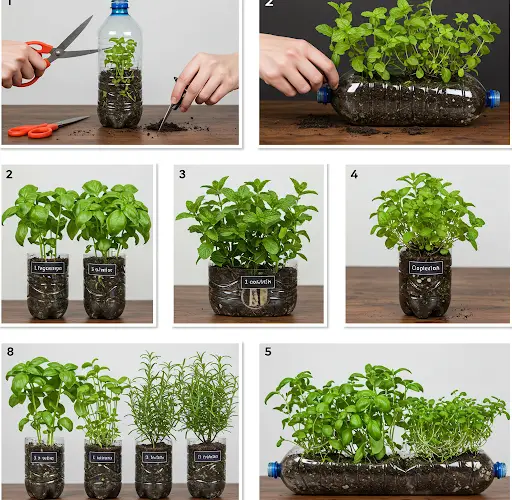Recycle Plastic Bottles to Grow Herbs and Spices for Home Meals
If you’re looking for a sustainable and low-cost way to grow your own herbs and spices at home, plastic bottle gardening might be the perfect solution. Instead of throwing used bottles into the trash, they can be transformed into mini planters that not only help reduce plastic waste but also bring fresh, flavorful ingredients right to your kitchen. Whether you live in an apartment, a house with limited yard space, or just want to make your cooking more sustainable, this project is simple, fun, and practical.
Why Use Plastic Bottles for Gardening?
Plastic bottles are durable, lightweight, and easy to work with. They’re also widely available, making them an excellent option for upcycled gardening. By turning plastic waste into something productive, you contribute to a greener environment while also cultivating your own supply of herbs like basil, mint, cilantro, chives, oregano, and even small pepper plants.
This method is especially beneficial for urban gardeners or anyone interested in vertical or container gardening. It allows for creative arrangement, takes up minimal space, and requires very little maintenance once set up.
What You’ll Need
To start your bottle garden, you’ll need the following materials:
-
Clean, empty plastic bottles (preferably 1.5 to 2-liter sizes)
-
Scissors or a utility knife
-
A nail or screwdriver (for making drainage holes)
-
Potting soil or a mix of organic compost and coconut fiber
-
Seeds or seedlings of your favorite herbs and spices
-
Optional: string, wire, or hooks if you’re planning a vertical garden
Step-by-Step Instructions
1. Prepare the Bottles
Start by washing the bottles thoroughly to remove any residue. Remove labels if desired for a cleaner look.
For a horizontal planter, cut out a rectangular section along one side of the bottle, leaving the rest of the structure intact. This cut-out section will serve as the top opening for planting.
For a vertical hanging planter, cut the bottle in half or make a small cut near the neck to act as an opening. Poke holes in the bottom for drainage.
2. Add Drainage Holes
Using a nail or screwdriver, carefully make small holes at the bottom of the bottle. This is essential to prevent water from accumulating and causing root rot.
If you’re making a hanging vertical garden, punch two holes on opposite sides near the top rim of the bottle so you can add string or wire for hanging.
3. Fill with Soil
Add your chosen potting soil or mix of organic compost and coconut fiber. Make sure the soil is light and well-draining to support healthy root development.
4. Plant Your Herbs or Spices
You can start from seeds or small seedlings. Make small holes in the soil, insert the seeds or transplant the seedlings, and gently cover with more soil. Water lightly to moisten the soil.
Popular herbs to grow include:
-
Basil – loves warmth and regular watering
-
Mint – grows quickly and thrives in partial shade
-
Cilantro – prefers cooler temperatures and well-drained soil
-
Oregano – enjoys full sun and doesn’t require frequent watering
-
Chives – easy to grow and regrow after cutting
For spices like chili peppers or turmeric, make sure to choose slightly larger bottles and provide extra sunlight.
5. Arrange Your Bottle Garden
You can set the bottles on windowsills, balconies, or kitchen counters. If you’re short on space, create a vertical garden by hanging the bottles on a wall, fence, or balcony railing using hooks or wire.
Arrange the bottles to ensure each plant gets enough light. South-facing windows or well-lit balconies are ideal.
Care and Maintenance
Water your herbs regularly, but avoid overwatering. The drainage holes will help prevent excess moisture buildup. Most herbs prefer slightly moist soil and indirect sunlight, although some varieties like basil and oregano need full sun.
Fertilize lightly once a month using organic liquid fertilizer or compost tea. Trim your herbs regularly to encourage bushy growth and prevent them from flowering too early, which can reduce flavor.
Pests are rare in bottle gardens, but keep an eye out for aphids or fungus gnats. If needed, use a mild neem oil spray or a solution of water and soap to control infestations naturally.
Enjoy Fresh Herbs Anytime
One of the best parts about growing herbs in recycled plastic bottles is the convenience. Whenever you’re cooking, you can snip off fresh leaves of basil for pasta, mint for tea, or cilantro for your salsa—straight from your little garden.
Not only does this save money, but it also ensures that your food is seasoned with the freshest, pesticide-free ingredients. Plus, you’re contributing to sustainability by giving plastic waste a second life and reducing your carbon footprint.



